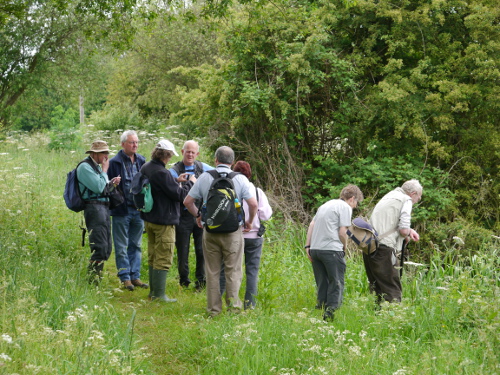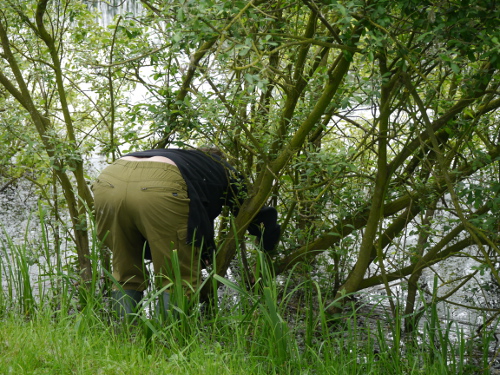|
|||||||||||||||||||||||||||||||||||||||||||||||||||||||||||||||||||||||||||||||||||||||||||||||||||||||||||||||||||||||||||||||||||||||||||||||||||||||||||||||||||||||||||||||||||||||||||||||||||||||||||||||||||||||||||||||||||||||||||||||||||||||||||||||||||||||||||||||||||
Warwickshire Dragonfly Group - News pageTable of Earliest Flight dates December 9th 2014 - Very late Migrant Hawker and 2014 year round up. October 2nd - 2014 September Banded
Demoiselle sightings. Hawkers still about in numbers. August 31st 2014 - New Small
Red-eyed Damselfly site August 16th 2014 - Report 0n Cannock
Chase field meeting July 7th 2014 -
Lesser Emperor sighted at Draycote Water June 23rd 2014 - First
Brown and Southern Hawkers and lots of Scarce Blue-tailed
Damselflies June 21st 2014 -
Report on Packington Park field meeting June 13th 2014 -
Scarce Chaser flying and other news June 8th
2014 - First flying
Black-tailed Skimmer of 2014 June 7th
2014 - First report of
Emperor Dragonfly flying this year plus more Hairy Dragonflies May 31st 2014 -
Report on the Ditchford Lakes field meeting May 21st 2014 - Scarce Blue-tailed Damselfly and more evidence of Club-tail breeding May 16th 2014 - Large
Red-eyed Damselfly flying and revised first date for
Four-spotted Chaser May 15th
2014 - Four-spotted Chaser and Azure
Damselfly out in the county May 7th 2014
- First Broad-bodied Chasers of the year May 5th
2014 - More first flights April 16th 2014 - First Large Red Damselflies of 2014 January 9th 2014 - Report on Steve
Cham's talk Table of
Late Flying Dragonflies
If you have any later dates for 2014 or later times for previous
years please let me have them.
Table of
Earliest Dates Recorded
December 9th - Very late Migrant Hawker and 2014 year round up.
Back to page top October 2nd - September Banded Demoiselle sightings. Hawkers still about in numbers. While cruising the Oxford Canal, John Curd sighted a few Banded Demoiselles on 9 September. There are only five later records for the species in the county, all except one seen in September. The latest record is for one early in November, see last flights. Hawkers are still about making the most of the warm dry September weather. Migrant Hawkers continue to be seen in considerable numbers with fewer Southern Hawkers and even fewer Brown Hawkers. Good numbers of Common Darter are flying and breeding and a few Ruddy Darter too. Be very careful when looking at Darters, some Common Darter males are very red now and easy to confuse with Ruddy Darter. Back to page top September 10th - Masses of Migrant Hawkers in the county and Small Red-eyed Damselfly is still flying Migrant Hawkers are widespread in the county and in very large numbers at some sites. Today, 10 September, Kay and Peter Reeve watched enthralled by the antics of forty or more males flying over and in the thick marginal beds of rushes at Frankton Ponds in the sunny warm weather. The many males were fairly tolerant of each other, flying and hovering over the rushes then diving deeply into them searching for females. The sound of their wings as they flew among the rushes was the characteristic sound of the afternoon. Occasional a successful male would fly out of the rushes with a female in tow and off into the trees to mate. The Small Red-eyed Damselfly is still present at a number of sites. At Berryfield Pool in the west of the county, yesterday, more than twenty were present - including mating and egg laying pairs. Back to page top August 31st - New Small
Red-eyed Damselfly site.
August 16th -
Cannock Chase field meeting
Back to page top
Back to page top August 1st - Latest news All the records received are now processed and in the Darter database. So far this year the total of records is 820. All county breeding species have been seen. The first flight table is complete, except for possible future sightings of vagrant species. Small Red-eyed Damselfly was remarkable early. The distribution maps are up to date to 1 August. A new site for Small Red-eyed Damselfly was found by Glyn Clark at the Blythe Valley Business Park on 12 July. We had a field meeting in the Park last year, see the report, and did not see it there then. The two individuals seen by Glyn may be the pioneers of a new colony. A number of sighting of Beautiful Demoiselle show that this species continues to expand its range. Those on the Cole were reported on earlier. Back to page top July 7th - Lesser Emperor sighted at Draycote Water
Back to page top June 23rd - First Brown and Southern Hawkers and lots of Scarce Blue-tailed Damselflies New firsts first, a Southern Hawker was seen at Brandon Marsh during the Adult Identification Course on the 15 June and a Brown Hawker on 17 June at Bubbenhall Wood by Jim Timms on 17 June, see the first flights table. Some really good news about the Scarce Blue-tailed Damselfly. Jon Bowley reports: June 15th:
a large emergence of Scarce Blue-tailed Damselflies, the first for
a few years, was fantastic . At least 120 were estimated extending
from the previously mentioned pools all along the eastern border
of the site in rough herbage. Males made up about 80-90%, but
females were probably well hidden and some orange aurantiaca types
were seen. A few males were also noted on seasonal puddles
in the centre of the site and in old flooded wheel ruts, the
latter an old site for them where I haven’t seen any for a few
years. Hopefully this means that the species will linger on at
this site for several years to come.
That says it all. Back to page top June 21st - Report on Packington Park field meeting
Back to page top June 13th - Scarce Chaser flying and other news
Back to page top June 8th - First flying Black-tailed Skimmer of 2014 Missed from the entry for 7 June. An emerging Black-tailed skimmer and two other individuals were seen by Kay and Peter Reeve at Brandon Marsh 5 June just beating Jim Timms who spotted one at Bubbenhall Meadow 6 June. First flights table updated. Back to page top June 7th - First report of Emperor Dragonfly flying this year plus more Hairy Dragonflies Jim Timms reports the rather late arrival of Emperor Dragonfly this year. He saw a male at Bubbenhall Meadow on 1 June, see the first flights table. Kay and Peter Reeve are very pleased to report two male Hairy Dragonflies patrolling along the reeds at Wormleighton Reservoir on 3 June. In late summer 2011 and 2012 water levels were extremely low in the reservoir because of work by British Waterways and, probably as a result of it, no Hairy Dragonflies were reported in there in either 2012 or 2013. Their return is welcome. Back to page top May 31st - Report on Ditchford Lakes field meeting
Back to page top May 21st - Scarce Blue-tailed Damselfly and more evidence of Club-tail breeding Our one county population of Scarce Blue-tailed Damselfly is hanging on. Jon Bowley spotted three males on 18 May. He wrote: The
Scarce Blue-tails were again in the area of the sludgy shallow
pools I saw one at last year, and in rough grass nearby. With
plenty of seasonal pools in this area caused by the wet
winter, hopefully the population will be maintained for
another year, though this part of the site could well be
destroyed over the next winter following the restoration of
the site for agriculture. This also appears to be my earliest
date for them, probably due to the unusually warm temperature
(around 23 degrees centigrade).
As Jon suggests, this is the earliest ever date they have been seen in Warwickshire - by six days, see the first flights table. Another excellent piece of news for Club-tailed Dragonfly. Following finding of an adult on 17 May by Peter Dooley & Tim Kell at Marlcliff, Kay Reeve found a female exuvia on the river at Bidford on Avon, Riverside Park on 19 May. It was very fresh and the dragonfly probably emerged that day. It is well worth visiting the Avon in the next 10 days or so to try your luck finding your own Club-tailed Dragonfly. Back to page top May 17th - Club-tailed Dragonfly on the Avon at Marlcliff and revised first date for Four-spotted Chaser - again! The sighting of a newly emerged Club-tailed Dragonfly by Peter Dooley, and moments later by Tim Kell, on the Avon at Marlcliff on 17 May is great news. It is the first record on the river since 2010 (there were two records away from the river in 2012). More surveying of the river in the next few weeks is needed to try and get a better indication of the size of the population. The species has been recorded on the Avon from the Warwicks/Worcester boundary at Marlcliff up to Stratford so it is worth looking anywhere along this stretch - and it is always possible it is else were on rivers in the area. Now it is Sarah Walters turn to be pushed off pole position for Four-spotted Chasers by Jeff Rankin who saw four at Marsh Lane Nature Reserve, Hampton-in-Arden on 8 May. Does anyone have an earlier record for this year? Back to page top May 16th - Large Red-eyed Damselfly flying and revised first date for Four-spotted Chaser About twenty Red-eyed Damselflies were seen at Kingsbury Water Park by John Walton 14.5.2014. Sarah Walters has pushed Keith Warmington's Four-spotted Chasers from pole position with a sighting at Alvecote Wood on 14 May. Back to page top May 15th - Four-spotted Chaser and Azure Damselfly flying in the county Four Azure Damselflies were spotted by Jim Timms at Bubbenhall Meadow on the 14 May. Keith Warmington found two Hairy Dragonflies a male and a female at Alvecote Pools, Pooley Fields on a warm 15 May. This is a very pleasing sighting because last year there were no reports of the species at Alvecote. Keith also recorded the first (received so far this year) Four-spotted Chasers of 2014, one each at Alvecote and Mancetter Quarry. Back to page top May 7th - First Broad-bodied Chasers of the year Sarah Walters reports to freshly emerged Broad-bodied Chasers at Alvecote wood on the 4th May. Back to page top May 5th - More first flights Adults of five more species have now been seen in the last five days. The first Common Blue Damselfly, immature, was found by John Harris at Dost Hill on 1st May and Kay & Peter Reeve saw three more immature individuals at Stockton Quarry on 4th May. 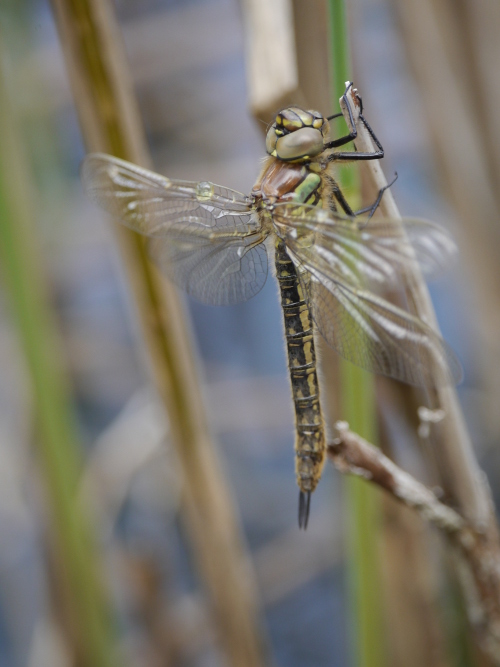 A female Hairy
Dragonfly was seen by Steven Falk at Stockton Quarry 3rd
May - resting on the hedge between Tasker's Meadow and disused
railway line. The next day Kay & Peter Reeve visited Stockton
Quarry, a hot spot for the Hairy, to see if it could be found. A
search for exuvia yielded eight, one male and seven female - quite
an unbalanced sex ratio. Just the one emerging female, shown left,
was found too. A female Hairy
Dragonfly was seen by Steven Falk at Stockton Quarry 3rd
May - resting on the hedge between Tasker's Meadow and disused
railway line. The next day Kay & Peter Reeve visited Stockton
Quarry, a hot spot for the Hairy, to see if it could be found. A
search for exuvia yielded eight, one male and seven female - quite
an unbalanced sex ratio. Just the one emerging female, shown left,
was found too.On 4th May Glyn Clarke recorded 28 Banded Demoiselles on the Avon at Longbridge, Warwick and Andy Barnsley had one in his garden, Mancetter. Kay & Peter Reeve counted eight at Marlcliff, Avon on 5th May (three females, five males). The first Beautiful Demoiselle on the Arrow at Coughton was found on 4th May by Des Jennings. The fifth species found today, 5th May, by Kay & Peter Reeve on the Avon at Marlcliff was an immature Blue-tailed Damselfly. Large Red Damselfly has now been recorded at several sites around the county. Back to page top April 16th 2014 - First Large Red Damselflies of 2014 The first report of adult damselflies of 2014 has been received from Jim and Carol Timms, 6 adult Large Red Damselflies at Bubbenhall Meadow. Not surprisingly, given the relatively warm winter, the date is early - the joint second earliest recorded in Warwickshire. The earlier date is 12.4.2011. If you have an earlier date for this year please send your record in. Back to page top
January 9th 2014 - A Personal Journey through 30 years of Dragonfly Watching – a series of short stories by Steve Cham. 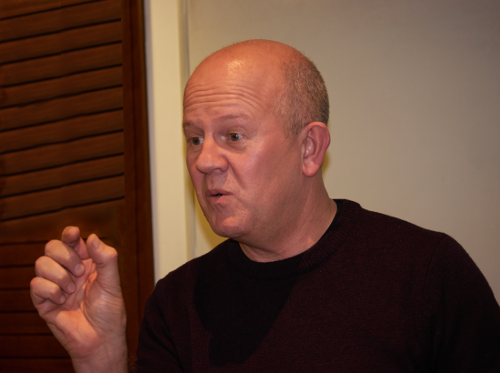 Steve's evening of
'stories' began with a review of early dragonfly watching. It is an
interest that developed rapidly in the 19th and first
half of the 20th centuries. Though not mentioned by
Steve, in Warwickshire we can be proud of our earlier pioneer 17th
Century naturalists, Francis Willughby and John Ray of Middelton
Hall, who studied them closely, for example: “speculating how an
adult dragonfly emerged from a larva only half its length” and
“observing dragonflies' mating' with 'curiosity’”. (See the Ray
Society website .) Steve's evening of
'stories' began with a review of early dragonfly watching. It is an
interest that developed rapidly in the 19th and first
half of the 20th centuries. Though not mentioned by
Steve, in Warwickshire we can be proud of our earlier pioneer 17th
Century naturalists, Francis Willughby and John Ray of Middelton
Hall, who studied them closely, for example: “speculating how an
adult dragonfly emerged from a larva only half its length” and
“observing dragonflies' mating' with 'curiosity’”. (See the Ray
Society website .)
Steve then went on to briefly explain what a dragonfly is using his photographs to illustrate their features. He then described his field studies of the behaviour and ecology of four species of dragonflies. As Steve put it, some were stories of 'sex and violence'. The 'Common Blue story' was certainly one of them. Fascinating detail was revealed by skilled photography showing behaviour not visible to the naked eye. Steve's photographs showed males diving down below the water surface into the depression caused by surface tension as the female submerges to avoid the attention of the males while egg laying. This amazing behaviour would be unobserved by the naked eye. It all happens very quickly and, usually, at a distance. After this, things became calmer! Steve went on to describe two
cases of misplaced site management: for Scarce Blue-tailed
Damselfly in Bedfordshire and the Downy Emerald in Epping Forest.
Well intentioned management at both sites resulted in the
extinction of the first species and the partial extinction the
second species at these sites. The case of the Scarce Blue-tailed
Damselfly is relevant to Warwickshire. The ecological management
requirements were known though they appeared somewhat
counter-intuitive. In the Bedfordshire case the habitat had been
kept open by youths driving 'bangers' around the site. For
seemingly good reasons, they were excluded by the site managers
and the seeps vegetated over by natural succession excluding the
sun and thus extinguishing the damselfly. The only Warwickshire
site is a working sand and gravel quarry. Here succession occurs
causing the damselfly to move from older to more recent areas of
extraction. A rolling programme of quarrying and gravel extraction
provides the best management policy allowing the species to move
to suitable breeding sites as old ones vegetate. Unfortunately,
the quarry is coming to an end of its working life and the outlook
for the population is bleak. Steve went on to describe a study he made in his own back garden of Southern Hawker. It showed that contributions to knowledge can be made very close to home – no need to go on expeditions to the equatorial forest! He described a delightful method for marking individual insects for re-identification when they return. It involved paint brushes on the end of sticks, creeping up on female Southern Hawkers while they are occupied with egg laying and dabbing spots of coloured paint on their wings! He wound up with what he called 'The Digital Era'. He discussed how the use of digital cameras allowed the teasing out of previously unknown behaviour of dragonflies that is not seen by the naked eye. This was shown to great effect in his study of the Common Blue Damselfly. Steve's talk left us with a feeling of having been at a lecture given by both an enthusiast and expert. It was full of hard scientific observation and illustrated by incomparable photographs. And all delivered intelligently and without the use of scientific jargon. Please send any item for inclusion on the news page to: Peter Reeve, Co-ordinator WDG
Banner artwork by Joan Sharrett
|
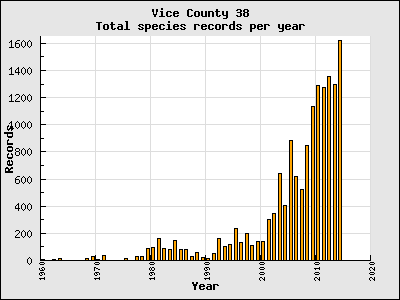 The warm late summer and autumn
helped
The warm late summer and autumn
helped 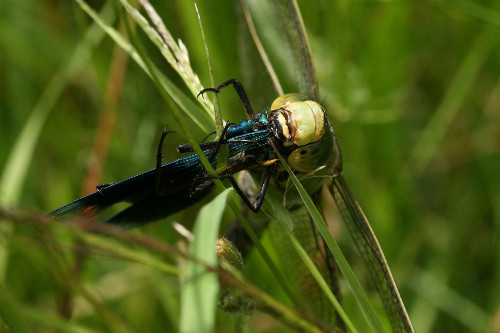 The year, with its warm summer
weather, has been good for dragonflies. As noted above,
particularly good for Migrant Hawker. It is also very
satisfying that our rarer species, Scarce Blue-tailed
Damselfly, Club-tailed Dragonfly and Scarce Chaser are still
surviving in the county.
The year, with its warm summer
weather, has been good for dragonflies. As noted above,
particularly good for Migrant Hawker. It is also very
satisfying that our rarer species, Scarce Blue-tailed
Damselfly, Club-tailed Dragonfly and Scarce Chaser are still
surviving in the county. 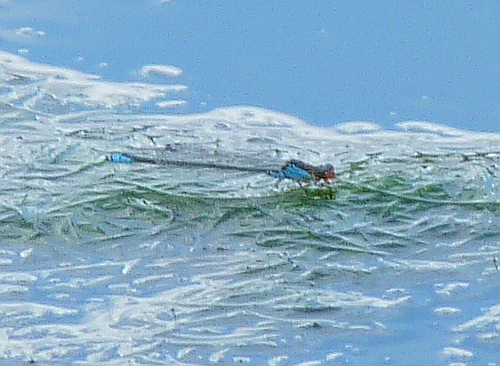
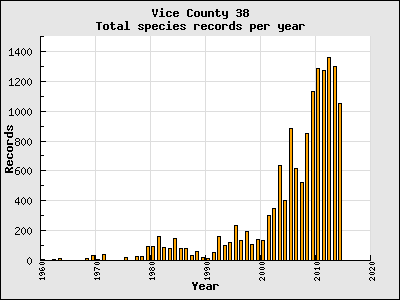 As
the histogram on the right shows numbers compares quite
well with the last three years - and there are still
records to come no doubt.
As
the histogram on the right shows numbers compares quite
well with the last three years - and there are still
records to come no doubt. 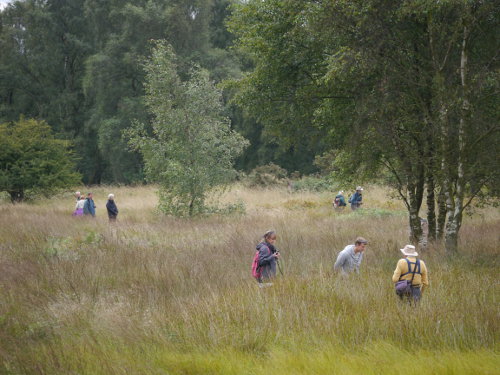
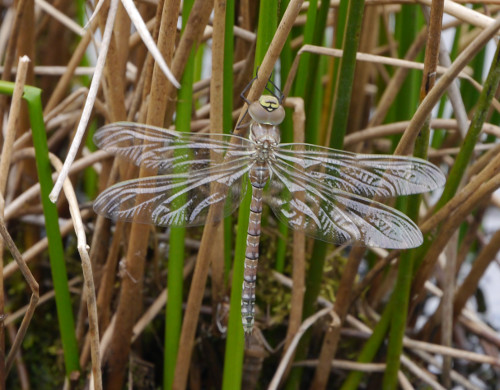
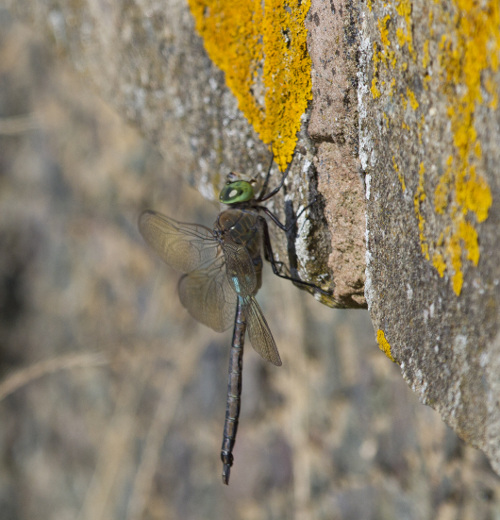
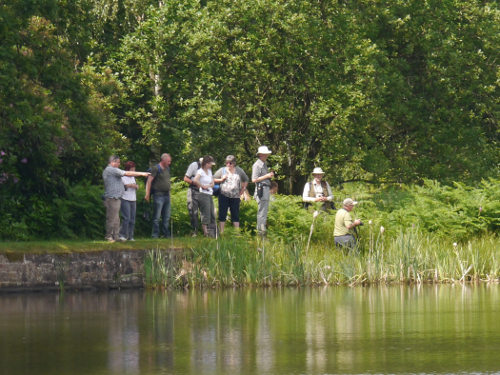
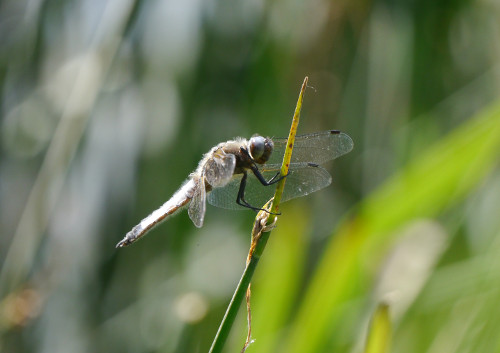 Great news.
Great news.
